Watercolor paints are often used in their work by professional artists. For beginners, this material is best suited, because thanks to watercolors, you can bring to life bright ideas for drawing.
Drawing tools
Before creating drawings, it is necessary to prepare the materials and tools that will be required for this.
Dye
This should be children's watercolors, specially designed for young artists, or professional gouache. The latter option is preferable, because children's watercolors have a low covering power. Because of this, the drawings turn out to be excessively primitive. Such paint does not paint the canvas well.

Gouache is an excellent choice for beginning artists who have never held drawing tools in their hands. It is best to choose professional gouache paint, for example, “Studio” or “Sonnet”.
It is not necessary to buy the most expensive gouache. Cheap paints are suitable for children's work. The minimum set contains a dozen basic paints. But if you mix them with each other in different proportions, you can get an infinite number of different colors.
More experienced artists have special tools in their arsenal that are designed to make work with gouache paints more qualitative. One of such tools is a palette knife. It is designed for mixing paints and for obtaining new colors, as well as for removing residues.
Brushes
To work with paints you will need several brushes.

There should be at least 3 of them:
- 1st – will be used to create smooth transitions from one color to another. The best brush for this role is a squirrel brush No. 6. Its main feature is that it absorbs moisture well;
- 2nd – is needed to highlight contours and work out small details of drawings. This should be a round kolinsky brush with a sharp tip;
- 3rd – will be used for color fills. A wide flat brush will do the job best.

If you plan to use gouache for your work, it is better to prepare harder brushes. Squirrel brushes are perfect for this type of paint. They are soft and their tip is well-sharpened. With their help, you can create distinct contours and make thin strokes.
For large drawings, such tools may seem insufficiently elastic, which will significantly slow down the drawing process. The disadvantages of squirrel brushes also include their tendency to wear out.
Kolinsky brushes are a good alternative to squirrel brushes. Their main advantages are good wear resistance and elasticity. However, you will have to pay more for their purchase. It is best to create a background and shade with a brush made of goat hair. Synthetic (nylon) tools are also suitable for this.
Paper
Ideas for painting with paints are best implemented on special canvases. You can't just take the first paper you come across. It's worth determining in advance whether it's suitable for painting with watercolors and gouache paints.
The main requirement is that the material on which beginning artists will paint should not be very dense. If the paper is too thick, the strokes will be choppy.
Plain A4 sheets, which are intended for the printer, are not suitable. Watercolor and gouache will simply spread across their surface.
If you plan to paint with watercolors, you should choose paper that does not absorb well. The best choice is special, hot-pressed paper. You can also buy NOT type paper.
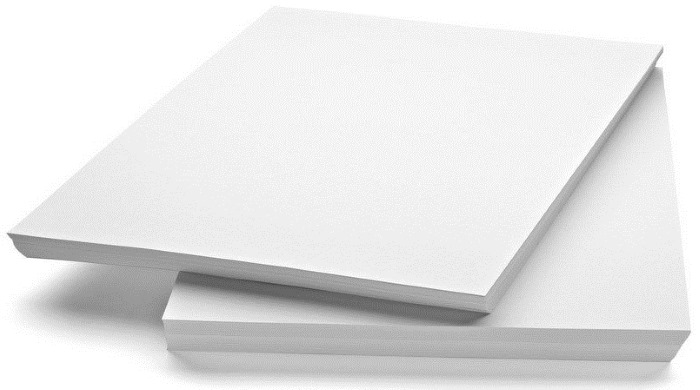
For gouache it is better to use thicker paper. Beginning artists are advised to create the simplest drawings on A4 paper, but only on unusual paper, the kind that has increased density.
You can also use A3 Whatman paper for gouache. This material is smooth, and the paint will lay on it very well. At the same time, the base does not get wet. Thin sheets will immediately warp upon contact with gouache paint.
Master classes
Once all the materials and drawing tools are prepared, you can begin the creative process.
Ideas for painting with paints should be simple at first - such that there are minimal problems when painting. At the same time, it will not be possible to avoid difficulties at all, because these will be the very first works.
Flowers
A simple drawing that can be easily painted with watercolors by beginning artists includes a small bouquet of bells. To create such a drawing, you will need several shades of green and blue. It is recommended to attach the paper to the table with pushpins so that it remains motionless while you work.
When creating the outline of a bell, it is not necessary to carefully draw each of its elements. A simplified schematic image will be enough.
In addition to paints, a pencil will be used. It is needed to create contours. It is important that the lines are not too thick. Otherwise, they will be visible even under a layer of watercolor. To create thinner lines, it is better to choose a hard pencil.
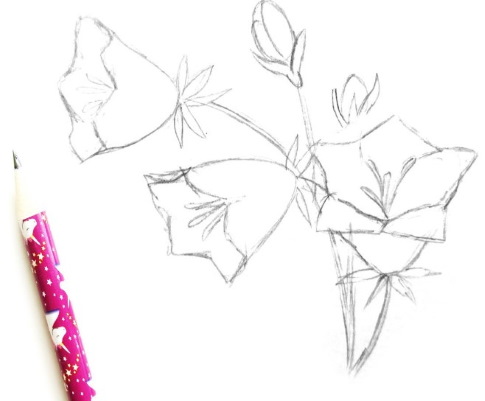
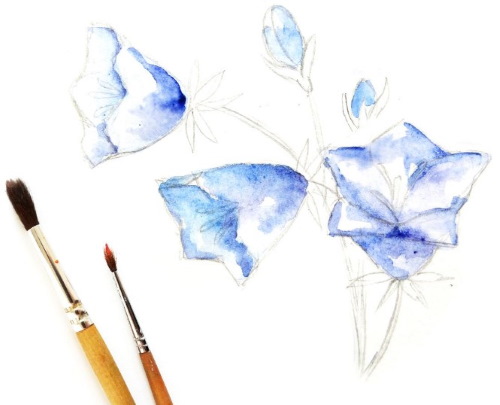
When all materials and tools are ready for work, you can begin the creative process:
- Moisten the paper sheet. Watercolor will adhere better to damp paper.
- When starting to work with paints, pay attention to which side the light is falling from. On the side that faces the light source, the paints should be lighter. Accordingly, on the side that is in the shadow, darker watercolors are used.
- Draw flower petals. First, apply the lightest tones to fill the contours, then apply darker shades on top.
It is recommended to use at least 2 different shades. The more there are, the more realistic the picture will be. It is important not to forget that after each applied layer the paper needs to dry. After 1 layer dries, you can move on to applying another.
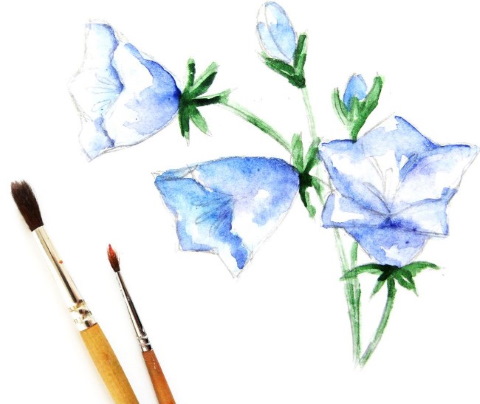
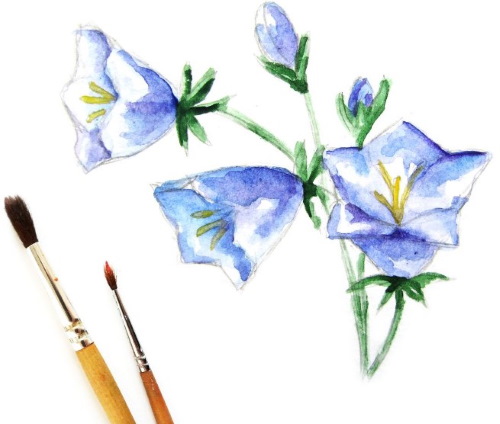
- Work on the shadows. There shouldn't be too many of them. It's better to make fewer shadows so that the picture doesn't turn out too monochromatic.
- Experimenting with shadows can be fraught with serious consequences. You won't be able to paint them over with blue or green paint later.
Carrots drawn with palms
Ideas for painting with paints can be realized not only with brushes. For example, kids will love the technique of "palm" painting, which allows them to do what they always want - to get their hands dirty with paints.
The main advantage of painting with palms is not the fulfillment of a child's dream, but the enormous benefits it brings to the growing body.
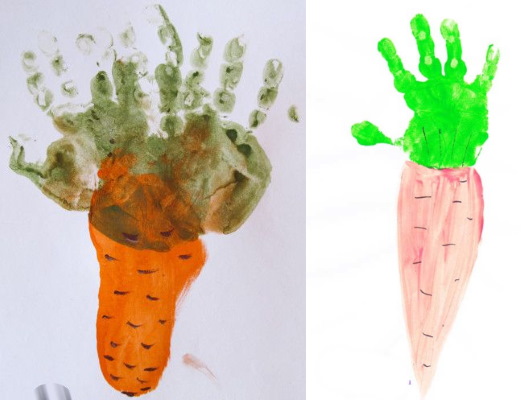
This technique:
- promotes the development of fine motor skills;
- develops perseverance;
- improves memory and attentiveness;
- affects the psyche.
For palm painting, you should use watercolor paint, an important advantage of which is safety. Watercolor is absolutely harmless. Even if a child tries to lick it off his hands, it will not cause harm to health.
Scientists have found that the index finger obeys the baby much better than any tool that he can hold in his hands. However, it is better to teach the child to use the other fingers along with the index finger.
For 3-year-olds, you should choose the most beautiful, but at the same time simple examples of drawings. For example, you can try to draw several carrots.
This work will take place in the following stages:
| No. | Stage | Description |
| 1 | Make the outlines of the vegetables | A simple pencil is used. If the child still has difficulty holding it in his hands, parents should help. You can take a real carrot and trace it several times to get 3-4 contours |
| 2 | Color the carrots | For this, orange gouache is used, preferably with a wide brush. |
| 3 | Finish drawing the tops | You need to stain your palm with green paint and apply it to the top of each carrot. |
Fish drawn with palms
Drawings with paints made by children's palms can be very different. An interesting idea for drawing is fish.
The steps to create such a picture are as follows:
- Prepare 2 sheets of paper.
- Pour a small amount of red gouache paint into a container.
- After staining your palm with this paint, make an imprint on paper.
- To make a cute fish, add a pair of eyes to the red prints.
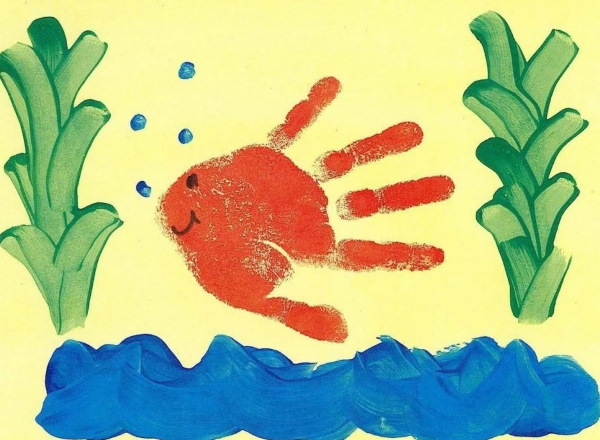
The drawing is ready.
Tree
Using the palm technique, you can easily draw a tree. To do this, take black or brown. On paper, as in other examples, apply a palm print. Then the resulting trunk needs to be decorated with leaves. This can also be done without using brushes. Good leaves are obtained from fingerprints.
Animals using palm technique
Using your imagination, you can create a large number of different drawings with your palms. Various animals will turn out well. The little finger, ring finger, middle finger and index finger will act as paws, and the thumb will become the tail. All that remains is to draw the head and, if necessary, other elements.
Apple
The sight of this fruit increases appetite. A drawing of an apple made with paints can have the same property. Anyone who sees an apple drawn on a piece of paper will definitely want to bite off a piece of this fruit.

If there is a real apple, then it can be used by a novice artist for copying. If there is no fruit, then you can find pictures or photographs with its image. In this case, it will be easier to work, since the object of copying always remains motionless. And the shadows on its surface and on the table also do not change.
Before you start working, it is worth looking at the real or drawn one. apple as an object with a certain shape:
- it is not monochromatic;
- there are shadows on its surface;
- the apple's shape is not round, but oval;
- at the top and bottom the oval line is slightly distorted;
- one side of the apple, which faced the sun, turned red under the direct influence of the rays of the daylight;
- its other side, which faced north, remained green;
- The green color has a depression at the place of the stalk, because it is also poorly illuminated by the sun.
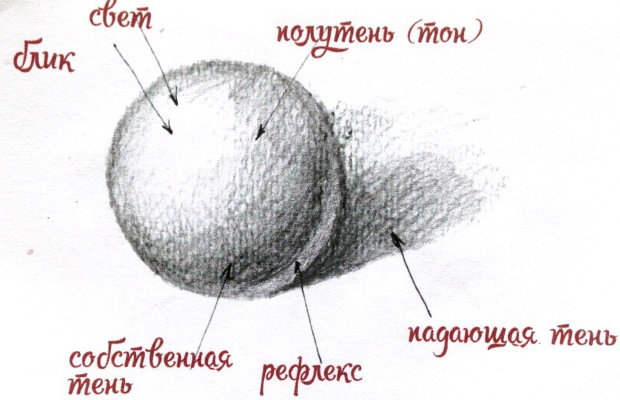
It is important to remember which side of the apple the sun is on when drawing highlights on the smooth skin of the fruit:
- on the side of the apple that faces the sun, there should be a glare;
- in the middle the light should be diffused;
- a shadow appears at the bottom left;
- There is also a shadow at the top and on the left side, but here it is less pronounced.
The work of drawing such an apple will ideally take several minutes and consist of the following stages:
- Create a sketch. You can use either the paint itself or a simple pencil for this. In the first case, you need to take a specially prepared round kolinsky brush with a round tip. It is very convenient to draw the borders with it, but the pencil can be any. The main thing is to draw with thin, barely noticeable strokes.

- If you plan to use gouache paint, it is recommended to wet the paper sheet with plain water beforehand. Gouache will lay down better on a damp surface.
- Start creating the first layer. It will be the base. You should use 2 colors - green and red. Both of them should be light.
- At this stage, you need to draw a small number of green and red specks on the top of the fruit. To "stretch" the colors, you just need to lightly touch the surface of the paper with the brush.
- When the first layer of green and red paint is created, start applying the next one. However, before doing this, you should wait until the previously applied watercolor completely dries. The picture needs to be complicated by adding a red color of medium tone to the right side of the fruit.
- The left side, which is not exposed to direct sunlight, should be painted with a watercolor mixture of green and brown.
- The highlights that will be on this apple don't actually need to be painted. The areas where they should be should be left unpainted.
- Add shadows to the resulting apple. They will give the drawn fruit realism. It is recommended to make them darker than on the source used. Usually, black paint is used to create shadows. However, in the case of an apple, the shaded areas can be dark purple.
- Draw the stalk and other small details.
Branch in the sun
One of the easy gouache drawings that is well suited for beginners is an autumn branch against the sun. Such a picture can be drawn without creating a sketch.

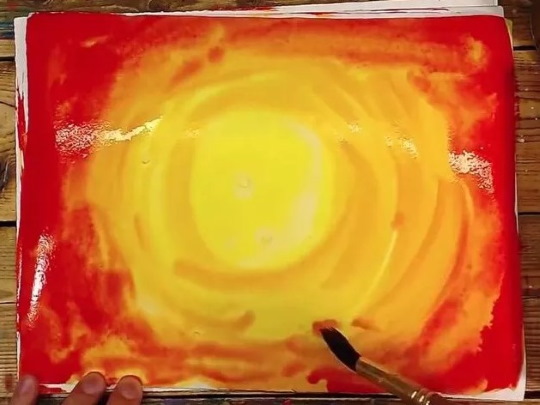
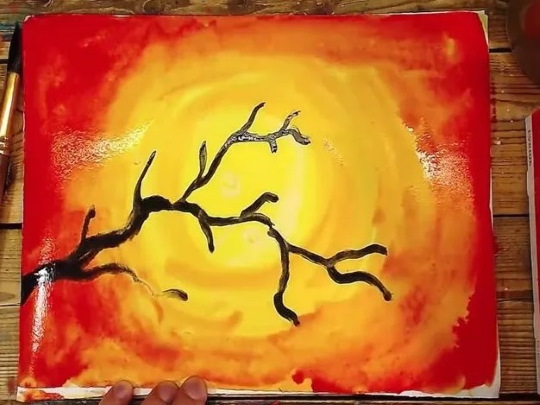

The work takes place in the following stages:
- Apply a background. To do this, apply yellow gouache to a white sheet of paper.
- Apply strokes of 2 colors in a circle: red and orange. The strokes should differ in shades. The lightest area of yellow should be in the center. As a result of all these efforts, you will get a sun that is about to set behind the horizon.
- Draw a circle around the drawn luminary with red paint to create its outline.
- When the drawing of the sun is completely ready, start drawing the autumn branch. Using brown paint, draw a silhouette from the edge of the sheet to its center.
- Decorate the branch with orange leaves.
Using cotton swabs
The role of brushes in painting can be replaced by ordinary cotton swabs. The method of creating designs based on the use of these products is called the "poke method".


The imprint of a cotton swab on a sheet of paper is small in size and round in shape, so it is good to draw small spots with it. For example, those that are found on animal fur.
Another option for using cotton swabs is to completely paint the drawing with numerous jabs. In this case, you will get a mosaic effect. Also, the traces left by such swabs can become the contours of an object.
Ideas for painting with cotton swabs can be as follows:
- falling snowflakes;
- raindrops;
- stars in the night sky;
- fruits of berry trees and bushes;
- grains for chickens or for mice.
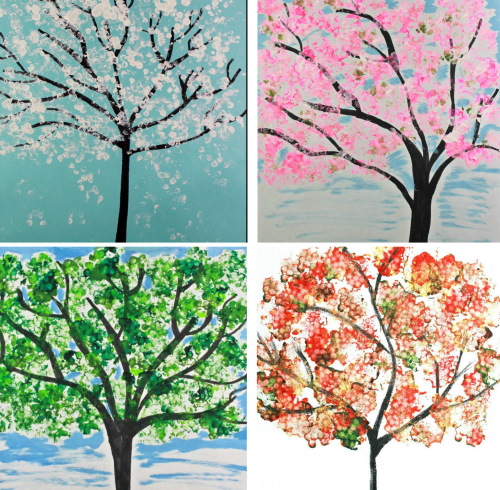
To speed up the process of creating such drawings, you can combine several sticks into one bundle using a string.
Using crumpled paper sheets
The role of brushes in painting with paints can be replaced by ordinary paper. The same material on which the picture is painted can serve as a tool for creating a drawing.
You will need a small piece of paper. It should be crumpled, then dipped in paint, and then - leave prints. The resulting picture will be distinguished by lightness and airiness. Gouache is better suited for painting in this technique than watercolor. In this case, you should first add water to the paint.

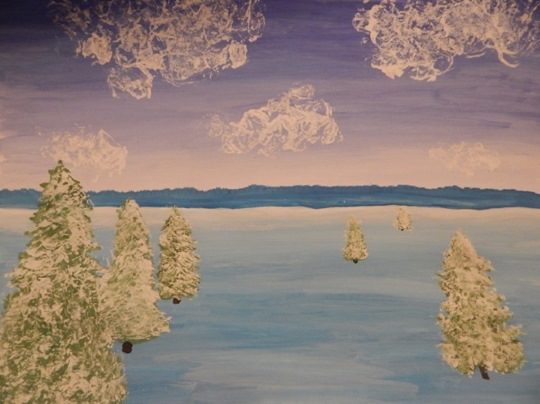
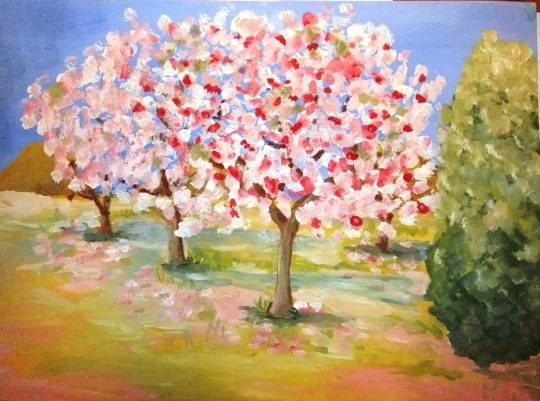
Using crumpled paper you can depict:
- yellow or white dandelions;
- fluffy clouds;
- snow-covered branches of a fir tree;
- flowers in the meadow.
This method is also good for coloring pictures. For example, you can use it to make a cat shaggy or an owl fluffier.
Gouache and watercolor paints help to take the first steps in painting. It is easy to draw with them, and the ideas embodied on paper turn out beautiful and fascinating. A child can easily master this art, and it is not necessary to attend special courses for this.
Video about drawing
Ideas for painting with paints:
